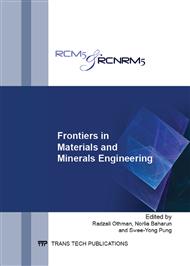p.46
p.52
p.56
p.60
p.67
p.74
p.80
p.88
p.96
Effect of Zinc Nitrate Concentration on Formation of AuNPs by Sacrificial Templated Growth Hydrothermal Approach and its Properties in Organic Memory Device
Abstract:
This paper describes a novel fabrication technique to grow gold nanoparticles (AuNPs) by using the sacrificial templated growth hydrothermal reaction approach. The effect of zinc nitrate Zn (NO3)2 concentration in the hydrothermal reaction on the formation of AuNPs was studied by varying the concentration from 0.01 M, 0.05 M, 0.1 M and 0.2 M. The increase of Zn (NO3)2 concentration lead to formation of smaller size and lower area density of AuNPs. XRD analysis proved the formation of AuNPs by using this approach. From scanning electron microscope images, the sample with 0.1M of Zn (NO3)2 concentration showed better AuNPs distribution. In order to investigate the memory properties of AuNPs embedded in organic insulator, polymethylsilsesquioxane (PMSSQ) was spin coated as insulator layer between the AuNPs. I-V and C-V characteristics showed hysteresis properties that indicated charge storage capability of AuNPs embedded organic insulator. AuNPs grown on 300°C annealed ZnO template in 0.1M of Zn (NO3)2 hydrothermal bath produced the best memory properties whereby 54 of electron charges has been stored per AuNPs in C-V measurement.
Info:
Periodical:
Pages:
67-73
Citation:
Online since:
November 2013
Authors:
Price:
Сopyright:
© 2014 Trans Tech Publications Ltd. All Rights Reserved
Share:
Citation:


